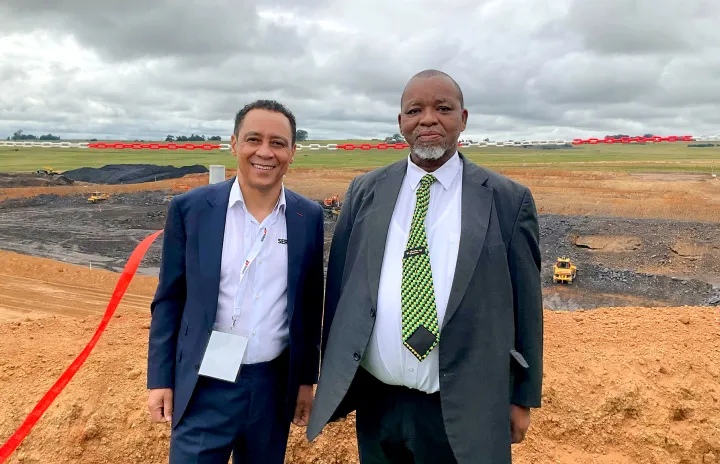The coal industry was supposed to be going the way of the dodo, but it is actually showing no sign of being an endangered species.
Coal producer Seriti Resources had the official launch for its Naudesbank Colliery near Carolina, Mpumalanga, on Friday, and Minerals and Petroleum Resources Minister Gwede Mantashe said more were in the pipeline.
“King Coal is back!,” a jovial Mantashe told Daily Maverick as he stood on a muddy embankment overlooking the open-cast mine as big yellow machines rumbled around a swelling mound of coal.
“We are still mining coal aggressively everywhere where we find it. There is no limitation. Look at this mine, it has a 20-year life,” Mantashe, a former coal miner himself, said.
Mantashe’s unapologetic affection for coal is well known.
But the public perception is that a new mine in South Africa – let alone a new coal colliery – is as rare as hen’s teeth.
South Africa is a party to the Paris climate accords, committing it to reducing its carbon emissions as part of the overarching goal to hold “the increase in the global average temperature to well below 2°C above pre-industrial levels” and pursue efforts “to limit the temperature increase to 1.5°C above pre-industrial levels”.
But Mantashe told Daily Maverick that the Naudesbank Colliery is the third new coal mine to open in Mpumalanga in the past six months.
And on the global stage, coal is displaying renewed signs of life.
According to the Global Energy Monitor, coal capacity in 2023 – the last year for which the data is available – grew 2% worldwide.
“Since the 2015 Paris Climate Agreement, almost all countries have reduced their coal-fired power plant capacity under development, and more than half the countries with coal-fired power plants have reduced or kept operating coal capacity flat,” it said in its latest annual review of the sector.
“However, despite promising momentum, the world’s operating coal power capacity has grown 11% since 2015, and global coal use and coal capacity reached an all-time high in 2023.”
China, in 2023, accounted for two-thirds of new coal capacity. But outside of China, the report noted that “the coal fleet also saw a small 4.7GW uptick for the first time since 2019”.
And 2023 also saw the biggest net increase in coal capacity worldwide since 2016.
Finance taps still open
It has also been the case that a growing number of banks have stopped providing finance for new coal projects – there would almost certainly be more capacity for the fossil fuel were it not for that trend.
But the brakes have also been applied on this front.
“In 2023, 23 top private financial institutions adopted new or updated coal policies, a significant slowdown from the 57 that adopted policies in 2022,” the Global Energy Monitor report noted.
In his remarks at the opening on Friday, Mantashe pointedly said: “Coal is growing and the discussions are changing… coal mining will be here in South Africa for about 200 years.”
Future historians will evaluate the accuracy of that assertion.
There are a number of reasons that coal has not gone into the precipitous decline that had been expected and that many greens have hoped for.
The green energy transition and global decarbonisation drive are in full throttle, but not yet at the pace needed to set the fossil fuel industry on the road to extinction.
China – as is often the case – has been the driving force. It is a leader in green energy but has also been adding new coal capacity at a rapid pace even as its dizzying rates of economic growth have slowed.
Trump 2.0 is also breathing new life into coal, and the fossil fuel industry still has a lot of clout worldwide, even as it claims to be embracing the energy transition.
But as they say, turkeys don’t vote for Christmas.
In the case of South Africa and other developing economies, the standard argument in defence of coal is that poorer nations should not have the same burdens as their wealthy peers whose own path to prosperity was paved with fossil fuels.
Critics say this is short-sighted as key markets such as the EU impose punitive measures on imports with heavy carbon footprints. And developing economies are and will continue to bear the brunt of rapid climate change – so it is in their interests to also decarbonise.
Seriti, a privately held, black-owned company, is in some ways a microcosm of these wider issues.
The mine will employ 300 workers and produce a million tonnes of coal a year for export – so it will create jobs and bring hard currency into South Africa.
Seriti also has a green unit – Seriti Green – and it has a 900MW renewable project. Of that, 155MW of wind energy will be used to power the company’s coal mines.
Coal producers are going green while simultaneously producing more of the stuff that has stuffed up the climate.
Coal may or may not be a thing in South Africa in 200 years. But the sun is hardly setting on the industry just yet.



